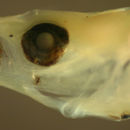en
names in breadcrumbs


Description: Body somewhat thick, long and narrow (pretransitional individuals can be relatively wide for this family) with a medium eye and a terminal medium-sized mouth. Pectoral fins short, reaching only about halfway to vent. Pelvic fins short and clearly separate. Dorsal and anal-fin bases very short and the front and middle rays are longer than the back rays making a triangular outline to the fin, caudal peduncle relatively wide and long and there are many procurrent caudal-fin rays in a distinct fleshy fold, from 12-14 in this larval type. Markings mostly along the ventral midline: melanophores usually as streaks (but often contracted and appear as spots) extending from the isthmus most of the way to the vent (if spots, there are 10 to 15), but absent below the swim bladder (which is the full thickness of the abdomen and provides a clear view of the retroperitoneum). There is an irregular paired row of melanophores along the bases of the last seven or eight anal-fin rays continuing as three or four streaks along the ventral midline of the peduncle ending at the start of the lower procurrent caudal-fin rays. The end of the caudal peduncle is uniformly covered by a wide bar of large melanophores, usually not extending all the way to the lower procurrent caudal rays or to the edge of the upper procurrent caudal-fin rays. Melanophores extend out along the proximal lower segmented caudal-fin rays and rarely along the distal portions of the central or upper segmented caudal rays. Only a rare individual has a small melanophore on the dorsal midline of the caudal peduncle forward of the start of the procurrent caudal-fin rays. Head markings on all individuals include melanophores at the angle of the jaw, along the dentary at the tip and below the dentary just to the side of the tip of the lower jaw. Head markings on most individuals include melanophores on the rim of the mid-maxilla, on the dentary of the mid-lower jaw, and below the nasal bones. Prominent melanophores extend over the surface of the iris on the dorsal half of the eyeball and paired around the base of the eyeball and, when expanded, melanophores almost cover the iris. Occasional individuals have a hidden melanophore overlying the cleithrum visible upon lifting the operculum (rarely paired). Internal melanophores surround the saccule and are present along the dorsal surface of the swim bladder and paired around the gut near the vent. There is a linear internal melanophore above the pelvic girdle, perhaps along the ventral postcleithrum and a few internal melanophores are often present around vertebral bodies near the tail and sometimes continuing along the hemal spine down to meet the midline melanophores. Series of transitional larvae show the body narrowing and thickening and development of the eye from a moderately narrowed vertical oval, tilting forward, with the pupil off-center dorsally and a slight posterior-inferior extension of the iris (there is also occasionally a marked dorsal and ventral indentation of the iris) to fully round. Transitional larvae develop a pattern of several discrete melanophores on the top of the head, at the midline behind the upper lip, and forward of the eye.
Eleotris amblyopsis larva
Eleotris amblyopsis larva
Eleotris amblyopsis larva
Eleotris amblyopsis larva
Eleotris amblyopsis larva
Eleotris amblyopsis larva
Eleotris amblyopsis larva
Eleotris amblyopsis larva
Eleotris amblyopsis larva
Eleotris amblyopsis larva
Eleotris amblyopsis larva
Eleotris amblyopsis larva
Eleotris amblyopsis larvae
Eleotris amblyopsis larvae
Eleotris amblyopsis transitional larva
Eleotris amblyopsis transitional larva
Diagnosis: Modal fin-ray counts of D-VI,9 A-9 Pect-16 indicate Eleotris amblyopsis. E. perniger is almost identical (and can co-occur with E. amblyopsis) but is reported to have a mode of 18 pectoral-fin rays with a range from 16 to 19 vs. a mode of 16 and a range of 15-18 for E. amblyopsis (Pezold 2002). The larval type described here has mostly 15 and 16 pectoral-fin rays. This is the only eleotrid genus with as few as 8 or 9 second dorsal and anal-fin elements and equal numbers. This taxon historically has been variably split: although E. pisonis has been considered the widespread Caribbean species and books refer to it as such, recent work by Pezold (2002) indicates that the true E. pisonis is South American, ranging from Orinoco-Venezuela to Brazil. Instead, E. amblyopsis occurs along the continental margin from the US to Venezuela and E. perniger is mostly of the Antilles, but co-occurs with E. amblyopsis along the Central American coast. Since the species are morphologically virtually identical, the larvae may be indistinguishable without DNA sequencing. Two larvae caught together on one day are larger than virtually all of the others, about 14.5 mm SL, and both have 17 pectoral-fin rays; it is possible that they represent E. perniger, although DNA sequence analysis will be required for confirmation. (U) G4
Analogues: The eleotrid larvae share a long thin body with relatively short dorsal and anal-fin bases, numerous procurrent caudal-fin rays, and a long ventral midline streak from the isthmus to the mid-abdomen. Larval Eleotris amblyopsis are distinguished by a wide caudal peduncle, a pigmented end to the caudal peduncle, and short wing-like dorsal and anal fins with no melanophores on the membranes.